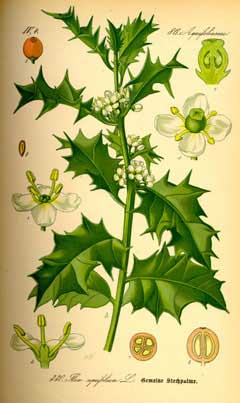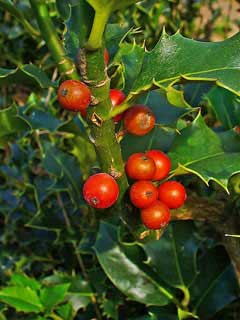 |
|
http://commons.wikimedia.org/wiki/File:Illustration_Ilex_aquifolium0.jpg |
 |
| http://commons.wikimedia.org/wiki/User:Llez |
Translate this page:
Summary
Bloom Color: Green, White. Main Bloom Time: Early spring, Late spring, Mid spring. Form: Pyramidal.
Physical Characteristics

 Ilex aquifolium is an evergreen Shrub growing to 9 m (29ft) by 5 m (16ft) at a slow rate.
Ilex aquifolium is an evergreen Shrub growing to 9 m (29ft) by 5 m (16ft) at a slow rate.
See above for USDA hardiness. It is hardy to UK zone 6 and is not frost tender. It is in leaf all year, in flower from May to June, and the seeds ripen from November to March. The species is dioecious (individual flowers are either male or female, but only one sex is to be found on any one plant so both male and female plants must be grown if seed is required). and is pollinated by Bees. The plant is not self-fertile.
It is noted for attracting wildlife.
Suitable for: light (sandy), medium (loamy) and heavy (clay) soils and can grow in heavy clay and nutritionally poor soils. Suitable pH: mildly acid, neutral and basic (mildly alkaline) soils and can grow in very acid soils.
It can grow in full shade (deep woodland) semi-shade (light woodland) or no shade. It prefers dry or moist soil and can tolerate drought. The plant can tolerate maritime exposure.
It can tolerate atmospheric pollution.
UK Hardiness Map
US Hardiness Map
Synonyms
Aquifolium croceum. Aquifolium heterophyllum. Aquifolium ilex. Ilex balearica
Plant Habitats
Woodland Garden Secondary; Sunny Edge; Dappled Shade; Shady Edge; not Deep Shade; Ground Cover; Hedge;
Edible Uses
Edible Parts:
Edible Uses: Tea
The leaves have been used as a tea substitute[4]. The roasted fruit has been used as a coffee substitute[7]. Some caution is advised here, since the fruit can be purgative and emetic[K].
References More on Edible Uses
Medicinal Uses
Plants For A Future can not take any responsibility for any adverse effects from the use of plants. Always seek advice from a professional before using a plant medicinally.
Astringent Bach Diaphoretic Diuretic Emetic Expectorant Febrifuge Purgative
Holly is little used in modern herbalism. The leaves are diaphoretic, expectorant, febrifuge and tonic[4, 9, 21]. They can be use fresh at almost any time of the year or can be harvested in late spring and dried for later use[4, 9]. They are used in the treatment of intermittent fevers, rheumatism, catarrh, pleurisy etc[4, 238, 254]. The juice of the fresh leaves has been successfully used in the treatment of jaundice[4]. The berries are violently emetic and purgative[4, 7]. They have been used in the treatment of dropsy and as a powder they have been used as an astringent to check bleeding[4]. The berries are toxic, especially to children, and should not be used medicinally except under professional supervision[254]. The root has been used as a diuretic, though there are more effective diuretics available[7]. The plant is used in Bach flower remedies - the keywords for prescribing it are 'Hatred', 'Envy', 'Jealousy' and 'Suspicion'[209].
References More on Medicinal Uses
The Bookshop: Edible Plant Books
Our Latest books on Perennial Plants For Food Forests and Permaculture Gardens in paperback or digital formats.

Edible Tropical Plants
Food Forest Plants for Hotter Conditions: 250+ Plants For Tropical Food Forests & Permaculture Gardens.
More

Edible Temperate Plants
Plants for Your Food Forest: 500 Plants for Temperate Food Forests & Permaculture Gardens.
More

More Books
PFAF have eight books available in paperback and digital formats. Browse the shop for more information.
Shop Now
Other Uses
Fuel Hedge Hedge Wood
An excellent hedge plant, tolerating hard clipping and maritime exposure and forming a dense stock-proof shelter[4, 11, 29, 75, 186]. Plants are fairly slow growing however[11]. The cultivar 'Pendula' makes a very good carpeting ground cover plant when grown as a cutting on its own roots[208]. It can be planted up to 1.2 metres apart each way, but is fairly slow to cover the ground[208]. Wood - strong, hard and dense, it polishes well, though it must be well dried and seasoned or else it warps badly. It is beautifully white, except at the centre of very old trees, and is highly regarded by cabinet makers though it must be well seasoned[4, 7, 46, 61]. The heartwood of mature trees is used for printing blocks, engravings, turnery etc[11, 115]. The wood makes a good fuel, burning well even when green[6]. Landscape Uses: Border, Screen, Standard, Specimen. The book 'Petite flore de France, Belgique, Luxembourg, Suisse" By Regis Thomas, David Busti, and Margarethe Maillard note that Ilex aquifolium has been used as a glue made from the bark to catch birds.
Special Uses
Attracts Wildlife Food Forest Ground cover Hedge Hedge Scented Plants
References More on Other Uses
Cultivation details
Succeeds in most soils, including peat, chalk, gravels, sand and shales[186], so long as they are not water-logged, though wild plants are occasionally found in situations with standing winter water[186]. Grows well in heavy clay soils[186]. Established plants are fairly drought tolerant[186]. Dislikes dry soils according to one report[31] whilst another says that it succeeds in dry shade[188]. Tolerates a pH range from 3.5 to 7.2[186]. Succeeds in full sun or fairly dense shade[17, 28, 31], self-sown seedlings from woods and shady places making the most shade tolerant plants[28]. Tolerant of maritime exposure[75] though in such a situation it may lose some or all its leaves in the winter[186]. Plants require a minimum July temperature of 12°c for good fruit production[186]. They tolerate short periods in winter down to -15°c[184]. Severe frosts can kill whole branches, especially if they are open to the sky[186]. The young growth in spring can be damaged by late frosts. A very ornamental plant, there are many named varieties[182]. Flowers and fruits are formed on wood of the previous year's growth[229]. A good bee plant[108], the minute flowers are sweetly scented[245]. The fruit is a valuable winter food source for birds. Resents root disturbance, especially as the plants get older[11]. It is best to place the plants into their permanent positions as soon as possible, perhaps giving some winter protection for their first year or two[K]. Only move the plants in May or, preferably, in September[1]. Plants are quite slow growing, even when in good soils and situations[11, 75]. Trees are usually dioecious but hermaphrodite forms are available. Male and female plants must usually be grown if seed is required. Plants are capable of regenerating from the main stem both above and below ground level and, although the top may be killed in a fire, the plants will usually regrow from the base[186]. Rabbits are particularly fond of this species and will quickly remove the bark. This species is notably resistant to honey fungus[200]. Special Features:
Attractive foliage, Not North American native, Naturalizing, Fragrant flowers, Inconspicuous flowers or blooms. In garden design, as well as the above-ground architecture of a plant, root structure considerations help in choosing plants that work together for their optimal soil requirements including nutrients and water. The root pattern is branching: a heart root, dividing from the crown into several primary roots going down and out [2-1].
References Carbon Farming Information and Carbon Sequestration Information
Temperature Converter
Type a value in the Celsius field to convert the value to Fahrenheit:
Fahrenheit:
The PFAF Bookshop
Plants For A Future have a number of books available in paperback and digital form. Book titles include Edible Plants, Edible Perennials, Edible Trees,Edible Shrubs, Woodland Gardening, and Temperate Food Forest Plants. Our new book is Food Forest Plants For Hotter Conditions (Tropical and Sub-Tropical).
Shop Now
Plant Propagation
Seed - best sown as soon as it is ripe in the autumn in a cold frame. It can take 18 months to germinate. Stored seed generally requires two winters and a summer before it will germinate and should be sown as soon as possible in a cold frame. Scarification, followed by a warm stratification and then a cold stratification may speed up the germination time[78, 80]. The seedlings are rather slow-growing. Pot them up into individual pots when they are large enough to handle and grow them on in light shade in a cold frame for their first year. It is possible to plant them out into a nursery bed in late spring of the following year, but they should not be left here for more than two years since they do not like being transplanted. Alternatively, grow them on in their pots for a second season and then plant them out into their permanent positions in late spring or early summer. Give them a good mulch and some protection for their first winter outdoors. Cuttings of almost ripe wood with a heel, August in a shaded position in a cold frame. Leave for 12 months before potting up. Layering in October. Takes 2 years.
Other Names
If available other names are mentioned here
Holly, English holl, Christmas Holly, Common Holly, English Holly
Native Range
TEMPERATE ASIA: Iran, Lebanon, Syria, Turkey EUROPE: United Kingdom, Albania, Bulgaria, Bosnia and Herzegovina, Croatia, Italy, North Macedonia, Montenegro, Serbia, Slovenia, Spain, France, Portugal AFRICA: Algeria, Morocco, Tunisia
Weed Potential
Right plant wrong place. We are currently updating this section.
Please note that a plant may be invasive in one area but may not in your area so it's worth checking.
Conservation Status
IUCN Red List of Threatened Plants Status :

Growth: S = slow M = medium F = fast. Soil: L = light (sandy) M = medium H = heavy (clay). pH: A = acid N = neutral B = basic (alkaline). Shade: F = full shade S = semi-shade N = no shade. Moisture: D = dry M = Moist We = wet Wa = water.
Now available:
Food Forest Plants for Mediterranean Conditions
350+ Perennial Plants For Mediterranean and Drier Food Forests and Permaculture Gardens.
[Paperback and eBook]
This is the third in Plants For A Future's series of plant guides for food forests tailored to
specific climate zones. Following volumes on temperate and tropical ecosystems, this book focuses
on species suited to Mediterranean conditions—regions with hot, dry summers and cool, wet winters,
often facing the added challenge of climate change.
Read More
Expert comment
Author
L.
Botanical References
1117200
Links / References
For a list of references used on this page please go here
Readers comment